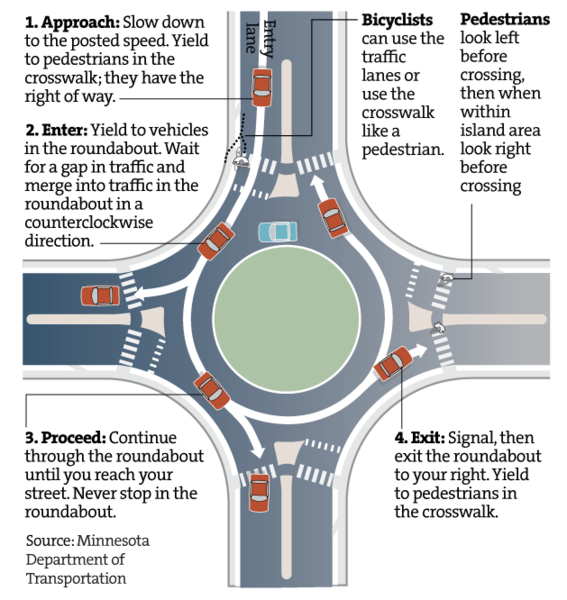|
Traffic circles are becoming more and more prevalent as cities look to install low-maintenance, bicycle-friendly traffic calming devices. A traffic circle is a small, circular island (much smaller than an actual roundabout) at the center of the intersection that slows traffic, causing vehicles to maneuver around the circle. Armatage residents have likely seen the traffic circle recently installed at 58th & Upton as part of the Upton bicycle boulevard project. At 40th & Zenith, a traffic circle is being tested to control speeds on Zenith and prevent additional right-angle crashes. The test consists of yield signs facing all legs of the intersection, orange delineators for the circle itself, and signage in the center of the intersection directing traffic to move in a counter-clockwise direction (to the right). This test circle will be removed before winter snow removal activities begin. If you have comments about the circle, I encourage you to call 311 to share your thoughts.
The maneuvering around traffic circles, however, is still new to many of us. The key point to remember is this: all cars must slow on approach and yield to vehicles already in the traffic circle. If you'd like a refresher on how to drive safely around a traffic circle, check out the diagram below, and watch this video (while the diagram and the video covers roundabout use, most of the principles still apply).

As my office continues to hear complaints from residents about increased airplane noise pollution over our neighborhoods, the City learned some news from the FAA (Federal Aviation Administration): on August 4, the FAA
suspended a certain operating procedure that was used at MSP, and the
suspension could result in some changes in how the runways and airspace are
used. Specifically, Runway 35 can no longer accept arriving airplanes when
Runway 30L is being used for departing aircraft over Minneapolis. You don’t
need to be familiar with the runways numbers to understand the issue.
Essentially, the two runways intersect, and the FAA has been carefully managing
the aircraft on each runway to make sure that arriving airplanes and departing
planes do not collide. The big concern is not about planes crossing on the
ground; the concern is about the potential for conflict in the air if the
arriving airplane needs to abort its landing and do a go-around. The NTSB (National Transportation Safety Board) has
indicated that they aren’t entirely satisfied with measures in place to avoid a
collision when conditions like this exist (at any airport). The FAA has
stated that the procedure is “temporarily suspended” -- we don’t know what that
means right now, but it does not sound like they will be using this procedure
again anytime soon.
It’s too soon to understand the implications of the
suspension, but this change significantly reduces the amount of arriving
airplanes that the airport can accept. The suspension means that MSP can now
accept about 60 planes per hour instead of the potential for 90. A
reduction in flights might sound like a great thing, but the FAA says they are
looking for alternative ways to accommodate the current capacity of the
airport. They are looking at alternate configurations which could result
in big changes in how runways are used, air traffic patterns, and the areas
that are exposed to noise. There are more questions than answers today, but as
I learn more I’ll keep you posted. (If you are not currently subscribed to my airport-specific newsletter, please contact Emily Ziring [Emily.Ziring@MinneapolisMN.gov] to have yourself added.)
You may
notice some changes in the air traffic patterns you are accustomed to. This is
the beginning of a conversation with you, the FAA, and the Metropolitan
Airports Commission (MAC) about what this means and how it affects our
community in the short and long term. The airport is in the process of updating
their Long Term Comprehensive Plan and this is an issue that will need to be
examined and addressed before that process can continue.

As a Council Member, a favorite part of my job is serving on the Minneapolis Youth Coordinating Board (YCB). The YCB is a joint project of the City of Minneapolis, Hennepin County, the Minneapolis Park & Recreation Board and Minneapolis Public Schools, and is tasked with promoting the health, education and safety of our city's youth. The YCB Minneapolis Afterschool Network recently launched its citywide program finder, What’s Up 612!, an online resource of things to do outside of the classroom in Minneapolis. The program finder is a citywide resource where youth, parents, educators, youth workers and persons who know young people can find afterschool activities for children and youth ages 5-21. What’s Up 612! brings together afterschool opportunities offered by both local government entities and community organizations.
The website is one component of the Minneapolis Afterschool Network, the citywide out-of-school time system created to ensure all of Minneapolis young people have access to the kinds of comprehensive, high-quality afterschool programs that support positive youth development, educational achievement, and career and community readiness. The board developed this tool not only for connecting parents, youth, educators and youth workers with out-of-school time activities, but also for addressing and shrinking the opportunity gap.
In addition, users will have the opportunity to offer suggestions, connect with fellow users via social media as well as participate in community activities and events. Community program providers are encouraged to submit program content to keep the program finder up-to-date with new and exciting opportunities.
YCB in the News
Check out this article from the Milwaukee Journal Sentinel on how Minneapolis YCB is serving as a model for other cities.
|
The City Council has approved goals calling
for Minneapolis to recycle and compost 50 percent of its citywide waste by
2020, and 80 percent by 2030. As part of the Mayor's Zero-Waste Minneapolis Policy Workgroup, I was proud to help set these goals. The adopted resolution will help the City meet
new recycling goals set by the State and Hennepin County in 2014.
The goals also call for the City to achieve a
0% growth rate in its total waste stream from levels set in 2010.
Reducing waste levels is an important step toward making Minneapolis a
zero-waste city. Along with producing less waste, the zero-waste philosophy
focuses on turning all discarded materials into resources for other uses
through processes like recycling and composting.
Minneapolis has already made great strides in
reducing its waste. Since citywide one-sort recycling began, the overall
residential recycling rate has climbed from 18% in 2011 to 25% in
2014. With the addition of yard waste and a pilot organics recycling program,
the City recycled or composted 31% of the total residential waste
generated. A citywide residential organics recycling program will roll out in
two phases with collection for the areas in the first phase beginning this week.
The new comprehensive composting and
recycling goals clarify targets set in the City’s Climate Action Plan, which was adopted by the City Council in
2013. Setting goals is a part of the zero-waste planning work that Mayor Hodges
announced in her State of the City address this past April.
The City will now develop a zero-waste plan
for City Council consideration in spring 2016. Staff will also work with Mayor Hodges, Council Members, and the Minneapolis Community Environmental
Advisory Commission to organize stakeholder meetings to address waste prevention,
recycling and composting.
Don't forget to sign up for organics recycling!
Beginning this week, about 25% of the City's Solid Waste & Recycling customers are also
able to pull many more food and paper items out of their trash to collect for composting. There is no
extra charge to take part, but you do need to sign up!
As of this week, more than 31,000 Minneapolis households have signed up for organics recycling, almost 30% of Minneapolis homes. In the 13th ward, however, all of our neighborhoods are beating the city's average. Here's what percentage of customers have signed up in each neighborhood:
- Armatage – 31%
- East Harriet – 40%
- Fulton – 36%
- Kenny – 33%
- Linden Hills – 62%
- Lynnhurst – 44%
-
West Calhoun – 36%
While Linden Hills' participation is much higher than other neighborhoods, they have been participating in a pilot program for several years. Lynnhurst has the highest participation rate of any neighborhood in the city that was not part of that pilot program!
If you’re a Minneapolis Solid Waste and
Recycling customer, you can request a cart by emailing swrcustomer@minneapolismn.gov – make sure to include your address – or call
612-673-2917 . .
For more details about the program's rollout, drop-off sites, and what you can place in organics recycling bins, see the City's organics website.
 National Night Out was a success across Minneapolis, but especially in the 13th Ward, where we hosted just shy of 300 events! The MPD brought its horses to several block parties, including this one on Vincent Ave.
Are you facing an issue with the City? My office is glad to try and help! Whether this means a phone call, an email conversation, or an in-person meeting (I'm happy to meet constituents in the ward!), please reach out.
Phone: 612.673.2213
Online: http://www.ci.minneapolis.mn.us/ward13/contact-ward13
|